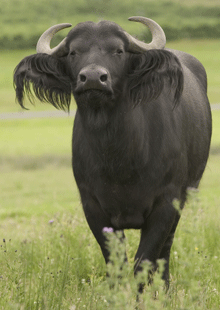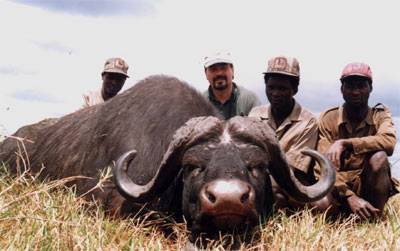|
The term buffalo must not be
confused with the colloquial use of the term in other
parts of the world. American bison are frequently and
incorrectly referred to as buffalo. The African species is
not closely related to either the North American bison or
the Asian water buffalo. Africa actually has two forms of
buffalo: a small version endemic to West African forest
known as the Red Buffalo (a subspecies very little is
known about) and the savanna species, also called the
black buffalo or the Cape Buffalo.
Our current understanding of the subject reflects
that bovines evolved in Asia around 7 million years ago,
which makes them the most recent of the advanced
ruminants. From this region they radiated widely
throughout tropical and subtropical Asia, probably
crossing an ancient land bridge into what is today North
America. It is not known how these animals were able to
radiate as far south into Africa as they have.
| Classification |
|
Kingdom |
Animalia |
| Phylum |
Chordata |
| Class |
Mammalia |
| Order |
Artiodactyla |
| Family |
Bovidae |
| Tribe |
Bovini |
| Genus |
Syncerus |
| Species |
caffer |
|
|
Common Name |
|
English
|
Cape Buffalo / African buffalo
/ Black buffalo |
|
German |
Afrikanischer Buffel |
|
French |
Buffle d' Afrique |
|
Afrikaans |
Buffel |
|
Zulu |
Nyathi |
| Swahili |
Nyari |
|
Description
While not closely related, buffalo look remarkably similar
to domestic cattle but are generally black in colour. They
may grow to massive size with recorded weights reaching
870 Kgs (1910lbs.). A buffalo's most distinctive feature
is its horns. These are present in both males and females.
The horns arise from a large structure on top of their
heads called a 'boss'. This structure is actually made up
of two 'boss halves'.
The horns are bilaterally symmetrical and grow
outward from the centre of the boss, eventually curving
upward and back inward in a gentle arc. Females have the
same shape but are generally lighter in build. In males
the boss halves grow together forming a 'shield' in front
and above its eyes. This is the part that makes contact
when two males butt each other. The greatest recorded
length for buffalo horns was 1.295m (4.27ft) measured over
the outside curve from the centre of the boss to the tip
of the horn.
Statistics
Length - MALE 2.5m (8.3ft) FEMALE 2.36m (7.8ft)
Shoulder Height - MALE 1.6m (5.3ft) FEMALE1.5m (5ft)
Weight MALE 680Kg (1500lbs.) FEMALE 600Kg (1320lbs.)
Gestation period : 330 days
Food preference : Grazer
Maximum speed : 56kph (35mph)
Social grouping : Large herds
Longevity : ±20 - 25 years
Food and Eating
Buffalo are bulk grazers and will eat a wide variety of
grass types. These include the longer dry grasses, which
they seem to prefer to new growth shoots. By eating the
longer grass buffalo play a very important role in the
grazing succession ecology of a region. By selecting this
type of grass they effectively open up that portion of
grassland to other species who can only, or prefer to, eat
shorter grass.
Buffalo will range over a very wide area in search
of the plentiful food supply that is necessary to satisfy
the needs of these large herds. Recorded movements have
shown these animals to walk up to 17 Km (10.5 miles) a
day. These treks often take them a fair distance from
water, a substance that they are dependant upon daily.
Buffalo will drink (when possible) directly after
feeding in the morning and again before feeding in the
afternoon. Their water intake averages between 60 and 80
litres (16 - 21 gallons) per day. The males often indulge
in mud wallowing when near water, particularly during the
hotter parts of the day. As well as a (minimal) cooling
effect, this also protects the animals against biting
flies, and helps in reducing their external parasite
(ticks) load. Since females almost never engage in this
activity it is assumed that wallowing may also serve an
additional function, probably social in nature.
Buffalo prefer not to graze during the heat of the
day (being quite sensitive to heat); most foraging occurs
in the early morning, late afternoon and at night. During
the midday heat these large ruminants will lie up in deep
bush or in the shade of trees to ruminate. In addition to
grazing and drinking, buffalo also exhibit other common
practices in order to obtain their mineral requirements.
These include using salt licks (if available), licking
termite mounds and licking the mud that has adhered to
their companions. Although they are able to consume a
large amount of grass, it is not nutrient rich. Therefore
20 out of 24 hours a day are spent grazing or ruminating.
Social Behaviour
These gregarious herbivores gather into herds that may
range from a few individuals to over 3000 animals - a
sight certainly worth seeing. Common herds are a mixed
group of males and females of all ages, from new calves to
old bulls. Smaller bachelor herds form frequently and
solitary old bulls are also found. Within each of these
herds there is a strict hierarchy based on fighting
ability which obviously relates to the size of the animal.
Female rank is determined by reproductive status, with
mothers of young calves being afforded the highest rank.
Within large herd structures, rank is very important
as it determines the position in the herd where the animal
can stay. Those of higher rank tend to be in the front and
centre of the herd. This affords them better grazing and
maximum protection from predators. Conversely those of low
rank travel and feed at the back of the herd, and have to
be content with graze that had been rejected by those up
front. These animals are the most prone to predation and
are frequently culled from the back of the herd by lion.
As herds get larger the hierarchy becomes less well
defined; the stronger individuals meet less often, if at
all, in the milling community of thousands of animals.
The herd unit is structured differently depending on
the season. During the wet season the large herds fragment
into smaller units as water and grazing becomes more
plentiful. In a similar vein, bachelor herds of 10 - 30
animals get to exploit smaller ecological niches as they
do not need to find large areas of grazing land and water
to satisfy the needs of many animals. Movement of the herd
is determined by those in the front quarter, i.e. those
with high rank.
Typically a herd will move between established
grazing and water and the total distance (although
dependant on habitat) tends to average out at only 6 Km
(3.7 miles). These travels occur within reasonably defined
but not defended home ranges. Again the home range is
completely dependant on habitat and may differ between 60
and 250 Km2 (23 - 100 miles2 ).To emphasise the much
smaller niche required by smaller herds, one bachelor
group of 10-15 animals was able to establish a home range
of only 3 Km2 (1.1 mi2).
A frequent observation by anybody who has ever seen
lion attacking buffalo is that if the buffalo all turned
and ran at the lion, the predator would turn and flee.
Although this scenario is not often played out, a number
of these incidences have been documented. In one
particular case a whole pride of lions were 'treed'
(chased into a tree and kept there) by a herd of buffalo
after the pride had killed one of the herd.
Breeding
As is common with many mammals, calving coincides with the
optimal period of grass growth in December through to
February. Since buffalo have an 11.5 month gestation
period, most mating occurs in January through to March of
the previous year.
After her ± 330 day gestation she will produce a
single calf weighing in at 30 - 50 Kg (66-110 lbs.).
New-born calves can stand and suckle within ten minutes,
but it takes several weeks before they are able to follow
the herd properly. Calves will continue to suckle for up
to 15 months or until the mother produces another calf.
The calf remains close by her at all times for at least
two years.
Female calves always retain a strong social bond to
their mothers but the males quickly disperse into the main
body of the herd. Even under optimum conditions only 30 -
45% of calves will reach the relative maturity of 2 years
old. While still young they are susceptible to predation
by lion, leopard, cheetah, wild dog and spotted hyaena.
The adult buffalo can generally fight off all but the
lions.
Disease
The viral disease of cattle, pigs and buffalo, Rinderpest,
was introduced to Africa twice, both times by the Italian
military from the Middle East. The first outbreak in 1884
was stopped in the Sudan. The second outbreak in 1889
started in Ethiopia and cases were reported in Southern
Africa 7 years later, probably due to ox-wagon transports.
The disease ranks among the worst pandemics to strike
African game in the past two millennia. It is highly
contagious, spreading by aerial and fluid transmission.
Its mortality (kill rate) is 100%. Estimates say that only
1 out of every 10 000 animals infected, survived.
In an attempt to halt the spread, a 1000 Km (620
mile) veterinary fence was erected across the whole of
South Africa, but to no avail. It came down the west coast
into the Cape and then up along the south and east coasts,
affecting the whole country. Of the half a million buffalo
in Southern Africa all but 50 died. Along with the buffalo
more than 95% of the cattle on the whole continent also
succumbed to the disease. The only real benefit was that
the lack of buffalo and cattle led to the demise of tsetse
fly. Rinderpest does not affect humans. Rinderpest is a
disease of the past, but others have taken its place. Much
of our current population are carriers of foot and mouth
disease.
This does not kill the animals, but can cause them
to lose condition. More serious is that buffalo can
transmit it to domestic cattle, who are very susceptible
and do die from it. It is for this reason that there is
supposed to be strict control that does not allow domestic
animals to get within 10 Km (6 miles) of game reserves. In
the majority of regions veterinary cordon fences are in
place, but control is sorely lacking. The good news,
however, is that populations of disease free buffalo have
survived and are thriving. Thus the price distinction
between diseased and disease-free buffalo was made. The
transport of buffalo is very strictly controlled and new
reserves outside of foot and mouth endemic areas may only
purchase and transport disease-free animals. A whole
module on wildlife health and diseases is available at the
Wildlife Management Course.
(Source:
www.wildlifecampus.co.za)
|


